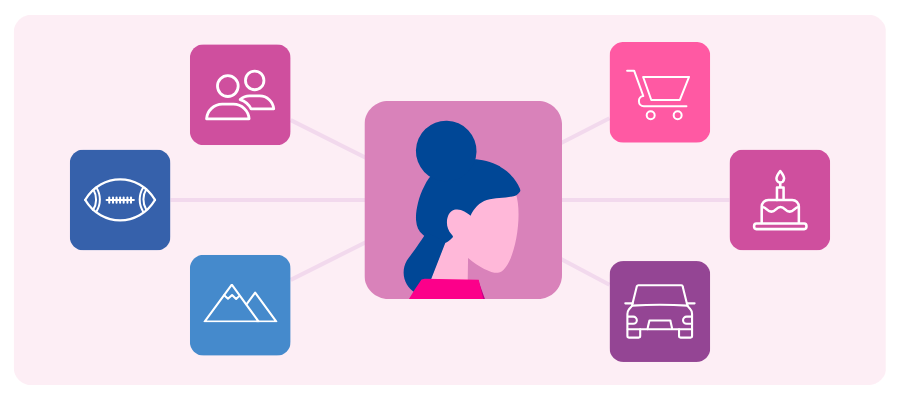At A Glance
Third-party data has moved from a fast-growth, loosely governed environment into one defined by trust, transparency, and compliance. Marketers are now looking for partners with institutional experience and rigorous data standards—not opportunistic providers chasing short-term gains. The brands that win will treat responsible data sourcing as the foundation of their customer strategy.How third-party data has changed and why it matters in 2025
For years, third-party data operated in an expansive, lightly regulated marketplace: fast-moving, high-growth, and filled with players eager to capitalize on digital marketing’s demand for audience insights.
That era is over. Regulatory scrutiny, stricter compliance standards, and rising consumer expectations have already transformed the market. Today, third-party data belongs to partners with proven expertise and built-in compliance. This isn’t a space for opportunistic newcomers; it’s one that rewards long-term commitment and trust.
Even the rapid rise of retail media networks (RMNs) reflects this shift. These platforms are built on long-standing, trusted relationships between brands, retailers, and data partners, utilizing that foundation in new ways to reach audiences responsibly and effectively.
The best providers have already made this transition; those still “shifting” are catching up.
From growth to governance: A market defined by accountability
The third-party data ecosystem has matured. After years of rapid expansion and recalibration, the market has stabilized around a new standard: data quality and regulatory accountability.
Third-party data enriches first-party insights with attributes such as income, gender, and interests that round out the customer view. But when the industry grew unchecked, unreliable providers diluted quality and trust. This resulted in a decline in the overall value and reliability of the third-party data marketplace.

That breakdown led directly to today’s privacy laws, now active across more than 20 U.S. states and numerous countries worldwide. These regulations reflect a permanent consumer expectation: relevance delivered responsibly. Consumers aren’t rejecting personalization; they’re rejecting how it’s been done in the past. They still want relevant, tailored experiences, but they expect brands to deliver them through ethical, transparent data practices.
Does third-party data still matter in a privacy-first era?
Third-party data isn’t disappearing, if anything, it’s become more important. Brands will always need additional insight to deepen customer understanding; first-party data alone only reflects what’s already known.
The industry has entered a mature phase where data quality and compliance are table stakes. The companies leading today built their data infrastructure on rigorous standards, regulatory foresight, and transparent governance.
That same foundation powers the next wave of innovation, including the explosive growth of RMNs. RMNs rely on responsibly sourced third-party data to enrich shopper insights, validate audiences, and extend addressability beyond their own walls. Trusted data partners make that expansion possible, connecting retail environments with broader media ecosystems while maintaining privacy and accuracy.
High-quality, compliant third-party data remains essential because it:
Advancements in AI and machine learning are reshaping how this data is used across the ecosystem. What was once primarily a buy-side tactic is now expanding into the sell-side, where publishers and platforms are using data to curate, package, and activate audiences more intelligently. As AI enhances modeling accuracy and automation, third-party data will play an even greater role in connecting brands and consumers in more meaningful, privacy-conscious ways.
The bottom line: it’s not about having more data; it’s about having better, verified data you can trust.
How can you spot a trustworthy data partner?
The strongest third-party data partners demonstrate accountability through experience, infrastructure, and integrity.
Look for providers that:
Why the future of third-party data depends on accountability
The third-party data industry has already crossed the threshold from expansion to accountability. The companies leading this era have established their credibility through governance and proof. The future belongs to providers that:
- Build with regulatory foresight
- Maintain rigorous quality assurance
- Prioritize partnership over profit
The Wild West days are long gone. The third-party data ecosystem is now defined by stability, transparency, and shared responsibility.
Partner with Experian for data you can trust and results you can prove
When accuracy and accountability define success, you need a partner built on both. Work with the company that’s setting the standard for responsible data-driven marketing and helping brands connect with people in meaningful, measurable ways.
Get started
About the author

Jeremy Meade
VP, Marketing Data Product & Operations, Experian
Jeremy Meade is VP, Marketing Data Product & Operations at Experian Marketing Services. With over 15 years of experience in marketing data, Jeremy has consistently led data product, engineering, and analytics functions. He has also played a pivotal role in spearheading the implementation of policies and procedures to ensure compliance with state privacy regulations at two industry-leading companies.
Third-party data FAQs
Third-party data is information collected by organizations that don’t have a direct relationship with the consumer. It supplements first-party data by adding demographic, behavioral, and interest-based insights.
Privacy regulations are reshaping data practices because consumers expect control over how their information is used. That expectation led directly to today’s privacy laws, now active across more than 20 U.S. states and numerous countries worldwide. These regulations reflect a permanent consumer expectation: relevance delivered responsibly. Consumers aren’t rejecting personalization; they’re rejecting how it’s been done in the past. They still want relevant, tailored experiences, but they expect brands to deliver them through ethical, transparent data practices. Laws like the CCPA and state-level privacy acts enforce this expectation, holding brands and data providers accountable for the ethical use of data.
Yes, brands can still use third-party data safely when sourced responsibly. Partnering with established, compliant providers like Experian ensures both legal protection and data accuracy.
Experian adheres to a set of global data principles designed to ensure ethical practices and consumer protection across all our operations. At Experian, privacy and compliance have long been built in. Every partner and audience goes through Experian’s rigorous review process to meet federal, state, and local consumer privacy laws. Decades of experience have shaped processes that emphasize risk mitigation, transparency, and accountability. Experian’s relationships with demand-side platforms (DSPs), supply-side platforms (SSPs), and even social platforms like Meta, ensures we are aware of any platform-specific initiatives that may impact audience targeting. We’re also active participants in many trade groups to ensure that the industry puts ethical data practices in place to ensure consumers still receive personalized experiences but their data usage and collection is opt-in, transparent and handled with their privacy at the center of the transaction.
Marketers should look for transparency, longevity, and evidence of compliance when looking for a data partner. The best partners can clearly explain how their data is sourced, validated, and maintained. Read Experian’s guide on how you can swipe right on the perfect data partner here.
Latest posts

Tracey Scheppach's new marketing and media practice leverages Tapad's device-level data to help clients achieve "marketing nirvana" NEW YORK and CHICAGO, April 5, 2017 /PRNewswire/ — Today, Tapad, now part of Experian, is the leading provider of unified, cross-screen marketing technology solutions, and Matter More, a next generation marketing and media practice with deep experience in the advanced TV space, announced a strategic partnership to bring together world class digital data and audience development expertise to help marketers improve how they connect with consumers. As consumer behavior continues to expand across multiple devices, today's marketers need robust, comprehensive data solutions to accurately engage the people who matter most to their brands. At the same time, the TV industry has reached an advertising tipping point, capitalizing on the power of device-level data. "Achieving unduplicated reach and frequency across all channels with true addressability, and the ability to measure outcomes, is marketing nirvana," says Tracey Scheppach, CEO and co-founder of Matter More, a new agency built for the modern age. "The best opportunity to deliver 'marketing nirvana,' at scale, is by partnering with Tapad and using their world-class Device Graph to help our clients simply matter more to the people they care about most." "By leveraging our access to rich TV data, we can now measure the actual performance of media across channels," says Marshall Wong, SVP, TV for Tapad. Tapad's proprietary Device Graph™ unifies consumer behavior data across all devices, uncovering the interests, passions and behaviors of the audiences who matter most. As with any data solution, privacy, transparency and trust are crucial to bringing marketers a solid offering that delivers results. "Tapad is excited to partner with Matter More to tap into their knowledge base and experience working with some of the largest brands on TV today," says Kate O'Loughlin, SVP and GM of Tapad's media division. "The time has come to truly unleash the power of device-level data at scale." Contact us today

Globalization affects retailers in a number of ways. Complying with commercial laws wherever they have brick-and-mortar stores is one such impact. Navigating through privacy rules that impact e-commerce efforts is another. There is one blind spot in particular that deserves attention — sending shopping cart abandonment emails. I am often asked, “How are abandonment emails treated under the CAN-SPAM Act? Canada’s stringent Anti-Spam Law (CASL)?” “Can I even send abandonment emails to my Canadian customers?” What are cart abandonment emails? But let’s back up… What is an ‘abandonment’ email anyway? In the email space shopping cart abandonment refers to a particular type of automated mailing used to re-engage an online customer. The most common example is one where a retailer notices that a customer has left an item sitting in their shopping cart, and proceeds to send a reminder with a coupon to complete the order. To fully understand privacy compliance pitfalls with this technique, in the U.S. and beyond, we need to unpack what happens before the abandonment email is sent. Email marketing shopping cart abandonment compliance Abandonment messages are almost always ‘commercial’, particularly if they incentivize a shopper to complete their purchase. In compliance parlance, we call this encouraging the continuation of a commercial activity. In contrast, an order confirmation typically provides factual information about a commercial activity. Under most anti-spam laws, particularly under CASL, marketers need to ensure abandonment messages are not unsolicited. Triggering should account for: Appropriate consent covering email marketing to new or ongoing online relationships. Scrubbing the customer’s email address against your unsubscribe/suppression lists before sending a solicitous message. (This is true under any anti-spam law.) For more information about CASL-compliant consent record keeping and related best practices, you can navigate to the Canadian Radio-television and Telecommunications Commission. Maintaining compliance with online tracking Abandonment emails rely on online retailers tracking their customers’ activity on their websites and tying online behavior back to the email addresses using the same behavioral targeting technologies as those used to deliver Interest Based Ads. This jump across engagement channels to remarket to customers can raise privacy concerns, so online retailers need to pay attention to their privacy compliance obligations. Cross-channel marketing privacy protections Guidance covering privacy policies and practices issued by the Federal Trade Commission are informative and I encourage you to review these with your law department. If you operate outside the U.S., privacy protection laws like Canada’s Personal Information Protection and Electronic Documents Act (PIPEDA) may set out additional obligations with your cross-channel marketing efforts. PIPEDA’s definition of commercial activity, which includes remarketing Privacy Commissioner’s findings under PIPEDA in relation to remarketing Privacy Commissioner’s guidance on online behavioral advertising, the technology of which informs triggered emails Under PIPEDA and similar international privacy regimes, cross-channel marketers will need to (i) clearly and conspicuous inform website visitors that their online activities may result in personalized marketing, (ii) offer a way to opt-out of such tracking, and (iii) obtain individuals’ prior express consent with tracking involving sensitive personal information such as health data How to manage cross-channel marketing compliance risks As privacy protection regimes around the world continue to mature and absorb rules covering marketing, online retailers need to start adding new vocabulary to their privacy compliance lexicon. For example, shopping cart abandonment efforts produce ‘cross-channel re-marketing campaigns triggered by an identifiable individual’s online behavior.’ While this is a mouthful to say, viewing your engagement efforts through this lens will help you manage compliance risks. Experian can help you navigate compliance risks Our privacy-first approach to data is trusted across industries around the world. As a leader in the industry, we are here to help you leverage the power of data while maintaining the highest standards of consumer privacy compliance and legal guidelines. With almost 30 years in business, we are here to help you confidently create and launch data-driven marketing strategies. Contact us today to get started! Please note: Cross-Channel Marketing does not give legal advice on electronic marketing regulations or privacy laws. To mitigate risk to your business, please consult with your legal counsel on the law and your corporate policy. Contact us today

Partnership combines customer connections and cross-device scale to deliver more strategic customer insights NEW YORK AND CHICAGO — March 16, 2017 – Signal, the global leader in customer identity, today announced a partnership with Tapad, now part of Experian and the leading provider of unified, cross-screen marketing technology solutions. This global integration extends device connectivity for Signal’s clients across North America, APAC and EMEA by leveraging Tapad’s proprietary Device GraphTM. With Signal’s Customer Identity Solution, brands benefit from more visibility of known customers, lower costs to reach those customers and decreased expenses and data loss that often results from using multiple vendors. Integrating with Tapad’s Device Graph, which connects billions of devices, enables Signal clients to build an even broader view of their known customers across multiple devices. This integration combines Signal’s customer identity scale with Tapad’s device scale to expand the reach of addressable media channels and enhance customer journey insights across touchpoints. Tapad and Signal were able to drive incremental device connections for more than 65 percent of customer profiles, linking an average of 6.8 browsers and devices per customer. With this combined data set, Signal clients can expand their authenticated view of a customer to all associated devices and realize more strategic insights into their high-value users. The partnership also allows Signal’s clients to integrate in real-time with Tapad’s media platform, Unify. This proprietary technology enables advertisers to make real-time activation and buying decisions with maximum scale, as well as automated reporting and measurement. “Continuously recognizing customers across devices instantly and in a privacy-safe way is essential for marketers to stay competitive,” said Marc Kiven, founder and CRO of Signal. “We are thrilled to enter this unique, global partnership with Tapad, enabling our clients to access their technology and more effectively reach customers in real-time and at scale.” “Being able to leverage a persistent view of customer connections across devices is a huge challenge for brands,” said Pierre Martensson, SVP and GM of Tapad’s global data division. “With Tapad, Signal is now able to connect with the billions of existing data points in our device graph to help clients better understand customer behavior and realize even stronger customer engagement.” Contact us today







